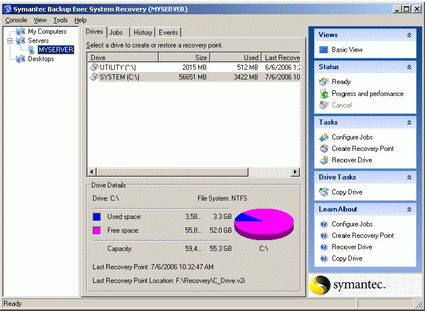6 Bare Metal Backup and Recovery Options
We look at full disk backup and restore packages for Microsoft Small Business Server and Vista desktops to help you decide what's best for your networks and systems.
Basic Characteristics Of Network/Server Backup
Backup
All three of these BMBR applications use wizards and Windows-Explorer-like interfaces to make backup and recovery a relatively simple process. Most of them also offer something analogous to "expert mode" operation, where you can get down and dirty with the interface and various switches and options at a low level of detail. They also support remote operation, with one machine on the network directing backup (and as much as possible, restore) over the wire as well.

The Backup Exec front-end console for selecting and launching backups is both reminiscent of Windows Explorer, and fairly typical for this type of application.
To back up a disk, you click on its entry in the Drive pane at the center of the window, then click "Create Recovery Point" in the right hand Tasks pane. To recover the drive, you click "Recover drive" instead. This automatically enables bare metal recovery, if that’s what is specified as the target for the recovery operation. Additional screens let you pick your target, establish compression levels, enable encryption (backup) or decrypt images (recovery), and so forth.
All three of the products include support for Microsoft SQL Server and Exchange Server. This is as you’d expect, because those elements belong to the collection that makes up Microsoft Small Business Server 2003. These programs include agents that use Microsoft APIs to back up SQL Server and Exchange databases while they are open. This includes use of the Volume Shadow Copy Service (VSCS) APIs to briefly halt database activity long enough to take snapshots of active databases in Windows 2003, including not just the aforementioned programs but also Active Directory.
In addition, all three of these products work with other VSCS products, including Microsoft Exchange 2003 and SQL Server 2005 (for those who may have updated these components within SBS). For other databases that aren’t VSCS compatible, these products include batch mode utilities that stop related services prior to backup, then restart them when the backup is finished. This really helps to illustrate why these products made the effort to support VSCS for key services (Exchange and SQL Server), to avoid the stop, backup, restart routine. For non-VSCS services, this means scheduling batch files that handle this three-step maneuver on your behalf during non-peak hours, or handling the task manually yourself.
Of course, you can also schedule backups of various kinds (complete, incremental, differential, and so forth) with all three of these applications. Each one offers a friendly and intelligible interface for scheduling such tasks.
Sign up to get the BEST of Tom's Guide direct to your inbox.
Get instant access to breaking news, the hottest reviews, great deals and helpful tips.
Current page: Basic Characteristics Of Network/Server Backup
Prev Page 6 Bare Metal Backup and Recovery Options Next Page Recovery